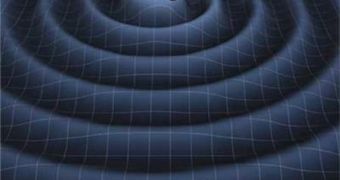According to scientists at the University of Bonn Argelander-Institut fur Astronomie, in Germany, it may be that astrophysicists will soon be able to observe the collisions of tens of pairs of black holes in star clusters. The team believes that the technology to allow for such direct observations may find its way into telescopes by as early as 2015. Details of their idea appear in the latest issue of the Monthly Notices of the Royal Astronomical Society, ScienceDaily reports.
The telescopes will not be surveying the actual collisions directly, as the black holes themselves emit no detectable trace that could indicate their presence. The observations will be done on a more subtle tone, by analyzing the gravitational waves that are theoretically produced when two such space structures collide and merge. These “waves” are actually distortions in space-time, and they propagate through the Universe regardless of what they meet in their paths. The technology to identify them could be made available within five years, the Bonn group believes.
“Physicists have looked for gravitational waves for more than half a century. But up to now they have proved elusive. If we are right then not only will gravitational waves be found so that General Relativity passes a key test but astronomers will soon have a completely new way to study the Universe. It seems fitting that almost exactly 100 years after Einstein published his theory, scientists should be able to use this exotic phenomenon to watch some of the most exotic events in the Cosmos,” BU Alexander von Humboldt postdoctoral fellow, Dr. Sambaran Banerjee says.
The expert, alongside colleagues Dr. Holger Baumgardt and Professor Pavel Kroupa, developed the first self-contained computer simulation of how black holes moved and interacted within star clusters. The work revealed that the black hole mergers would undoubtedly generate gravitational waves that would pass through ordinary objects such as stars, and distort them as they did so. These distortions will be the main target of the next generation of telescopes, although no one was thus far able to detect them with the existing technology.
One of the instruments that may be fitted for such observations is the Advanced Laser Interferometer Gravitational-wave Observatory (Advanced LIGO), which is scheduled to become operational by 2015. It will be able to detect such collisions and mergers at a maximum distance of five billion light-years away. Tens of the events could become available for scientific studies, the Bonn team says.

 14 DAY TRIAL //
14 DAY TRIAL //